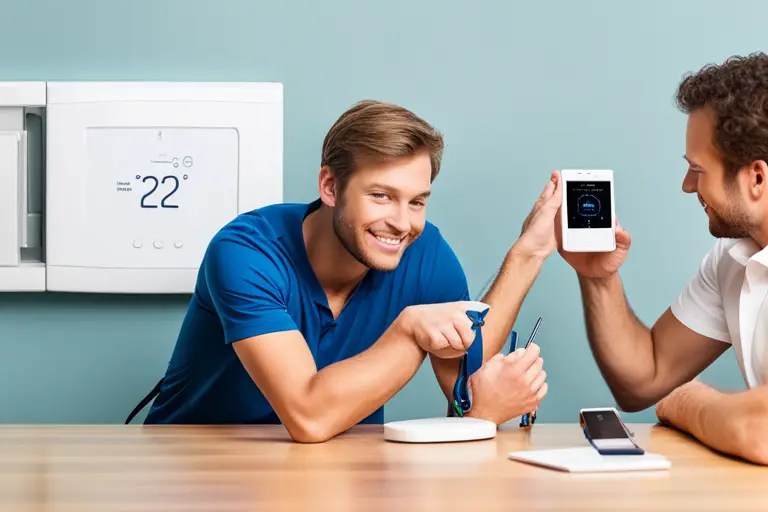Are you experiencing issues with your smart thermostat? Don’t worry, you’re not alone. Smart thermostats are designed to make your life easier, but sometimes they can be a bit finicky. Fortunately, there are simple troubleshooting tips and tricks you can try before calling in a professional.
One of the most common issues with smart thermostats is a lost connection to your Wi-Fi network. This can cause your thermostat to stop functioning properly, and you may not be able to control it through your mobile app.
In this article, we’ll show you how to check your Wi-Fi connection and troubleshoot any issues that may arise. We’ll also cover other common problems, such as calibration issues, display problems, and compatibility with your HVAC system.
With these tips and tricks, you’ll be able to get your smart thermostat back up and running in no time.
Checking Your Wi-Fi Connection
If you’re having trouble with your smart thermostat, the first thing you should do is check your Wi-Fi connection – it’s often the culprit behind a malfunctioning device.
Make sure your Wi-Fi is working properly by testing it on another device, like a phone or laptop. If it’s not working, try resetting your router or contacting your internet provider for assistance.
If your Wi-Fi is working fine, check that your thermostat is connected to the network. Go to the settings on your thermostat and look for the Wi-Fi option. Make sure it’s enabled and that it’s connected to your network.
If it’s not, try resetting your thermostat or contacting the manufacturer for further troubleshooting steps.
By checking your Wi-Fi connection and ensuring that your thermostat is properly connected, you can avoid unnecessary frustration and get your smart thermostat back up and running smoothly.
Calibrating Temperature Sensors
First, make sure your thermostat is accurately reading the temperature by calibrating the sensors. This is especially important if you’ve noticed that your thermostat is displaying temperatures that don’t match the actual temperature in your home.
To do this, you’ll need to use a thermometer to measure the temperature in the room where your thermostat is located. Then, adjust the thermostat’s temperature reading to match the reading on the thermometer. This process will vary depending on your specific thermostat, so make sure to consult the manufacturer’s instructions for guidance.
Once your thermostat is properly calibrated, you’ll be able to enjoy a more comfortable home. Your smart thermostat will be able to accurately maintain your desired temperature and make adjustments based on your preferences and habits. Plus, you’ll save energy and money by not overheating or overcooling your home.
So, take the time to calibrate your temperature sensors and reap the benefits of a properly functioning smart thermostat.
Resetting Your Thermostat
To reset your thermostat, you just need to locate the reset button and press it with a paperclip or small tool. This process will restore your thermostat to its default settings and erase any customizations you may have made.
If you’re experiencing issues with your thermostat, resetting it can be an effective troubleshooting method. When resetting your thermostat, it’s important to note that it may take a few minutes for the device to reboot and fully reset.
Additionally, some thermostats may require you to hold down the reset button for a certain amount of time before it will reset. If resetting your thermostat doesn’t solve your issue, it may be time to consult the user manual or contact customer support for further assistance.
Updating Firmware
Updating your thermostat’s firmware is a simple way to ensure that it’s running smoothly and efficiently. Firmware updates can fix bugs and improve overall performance. It’s important to regularly check for updates and install them as soon as they become available.
To update your thermostat’s firmware, first check the manufacturer’s website or app for any available updates. Follow the instructions provided to download and install the update onto your device. Make sure your thermostat is fully charged and connected to Wi-Fi before starting the update process.
Once the update is complete, your thermostat should automatically restart. You should notice improvements in its performance. Keep in mind that updating your firmware may also reset some of your thermostat’s settings. So, be sure to double-check and adjust any necessary settings after the update is complete.
Verifying Compatibility with HVAC System
Before attempting to install a new thermostat, it’s crucial to ensure that it is compatible with your HVAC system. This means that you need to understand the type of system you have and what kind of thermostat is compatible with it.
Some HVAC systems may require a specific type of thermostat, such as a low voltage or high voltage system. If you’re not sure, it’s best to consult with an HVAC professional or refer to your system’s manual to determine the correct type of thermostat.
Checking for compatibility can help prevent issues such as short-circuits, blown fuses, or damage to your HVAC system. It’s important to note that not all thermostats are compatible with all HVAC systems, and attempting to install an incompatible thermostat can cause serious damage.
By taking the time to verify compatibility, you can ensure that your new thermostat will work properly and efficiently with your existing HVAC system.
Troubleshooting Display Issues
You may notice that the display on your thermostat isn’t working properly, causing confusion when trying to adjust the temperature. If this is the case, there are a few things you can try to troubleshoot the issue.
First, check to make sure the thermostat is receiving power. If the display is completely blank, it may be that the batteries have died or the thermostat isn’t properly connected to the power source.
If the thermostat is receiving power but the display is still not working correctly, try resetting the device. This can often fix display issues and other problems with the thermostat. To reset the thermostat, simply turn off the power source for a few minutes and then turn it back on again.
If none of these steps work, it may be time to contact a professional for further assistance.
Contacting Customer Support
If you’ve tried troubleshooting the display issues on your smart thermostat and it’s still not working properly, don’t worry. There’s still a solution for you – contacting customer support.
Most smart thermostat manufacturers offer customer support services that can help you resolve any technical problems you might be experiencing.
When you contact customer support, be sure to have your smart thermostat model number and serial number handy. This will help the customer service representative assist you more efficiently.
Explain the issue you’re experiencing in detail and follow any troubleshooting steps they provide you with. If the problem still persists, the customer service representative may be able to provide you with further assistance or even replace the thermostat if it’s still under warranty.
Don’t hesitate to reach out to customer support if you need help – they’re there to help you get the most out of your smart thermostat.
Frequently Asked Questions
How do I know if my smart thermostat is compatible with my smart home system?
To check if your smart thermostat is compatible with your smart home system, first ensure that both devices use the same communication protocol, such as Wi-Fi or Z-Wave. Check the manufacturer’s website or manual for compatibility information.
How can I troubleshoot issues with my smart thermostat’s scheduling or programming?
To troubleshoot issues with your smart thermostat’s scheduling or programming, start by checking the app or website for updates or resetting the device. Make sure the thermostat is connected to Wi-Fi and that its schedule is set correctly.
Can I control my smart thermostat remotely when I’m away from home?
Yes, you can control your smart thermostat remotely when you’re away from home. Simply download the app associated with your thermostat and connect it to your Wi-Fi network. From there, you can adjust the temperature from anywhere.
What should I do if my smart thermostat is not responding to voice commands?
If your smart thermostat isn’t responding to voice commands, try these steps: check the Wi-Fi connection, ensure the microphone is not blocked or dirty, and make sure the voice assistant is compatible with your thermostat.
Is it possible to integrate my smart thermostat with other smart devices in my home, such as smart lights or smart locks?
Yes, you can integrate your smart thermostat with other smart devices in your home. This will allow you to control your thermostat, lights, locks and other devices through a single app. Simply check if your smart devices are compatible with your smart thermostat and follow the instructions to set them up.
Conclusion
Congratulations! You’ve successfully gone through the troubleshooting process for your smart thermostat. By following the tips and tricks outlined in this article, you should now be able to resolve most common issues with your device.
Remember to always check your Wi-Fi connection, calibrate temperature sensors, update firmware, verify compatibility with your HVAC system, and troubleshoot display issues.
If you have exhausted all these options and are still experiencing problems, don’t hesitate to contact customer support. They’re there to help you get the most out of your smart thermostat and ensure your home remains comfortable year-round.
With these tips, you can enjoy the convenience and energy savings of a smart thermostat without any frustration.

Hey there, tech enthusiasts! I’m your go-to content writer, delving into the fascinating world of technology hacks. Get ready to unlock mind-blowing secrets and discover innovative solutions through my engaging and insightful blogs.


